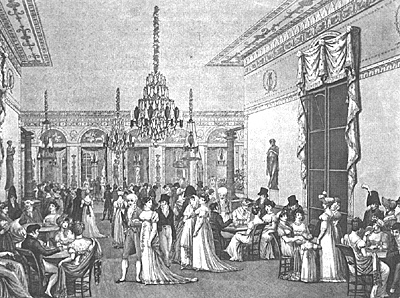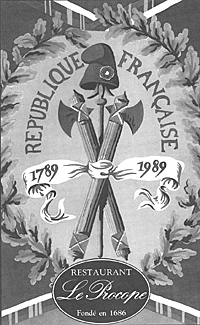It may not be known by many but the restaurant
[3] as we know it today
was a French invention of the 18th Century [4] that came to flower in the
years after the Revolution of 1789. By then the old
aristocratic households with their elaborate kitchen staffs
had disappeared. Many of the talented cooks who had
served these households found employment in the newly
emerging culinary institutions that were known as
restaurants.
As a result, the food of these uniquely democratic
establishments, where anyone could dine who could afford
to pay the bill, improved immensely. And from that time to
this, French restaurants have outshone all others in the
world'. This is partly because of the genius of the French
chefs and mostly because the French people apparently
care about food quality, its preparation and service - more
than anybody else in the world.
[5]
The first true restaurant is believed to have been
opened on the rue des Poulies in Paris in 1765. Its owner
was one Monsieur Boulanger (the word means baker, and
some authorities claim that he was a baker whose real name
has been forgotten.) Before Boulanger's days, there were
inns and hostels where simple meals were served to
overnight guests as well as cafes where drinks were
dispensed. But Boulanger's place was the first public
establishment, unassociated with traveling, where people
went simply to eat a meal.
His menu featured soups and dishes prepared with
the finest poultry and the freshest of eggs. Boulanger
evidently understood his business and all it's essentials.
Diderot, the encyclopedist and philosopher, visited the
eating emporium and reported: "I went to dine at the
restaurateur's place in the rue des Poulies; one is treated
well but has to pay dearly for that."
Yet Boulanger's restaurant was modest by our
modern standards. The first luxury restaurant in Paris was
the First Taverne de Londres on the rue de Richelieu, run
by a man named Beauvillier. [6] It opened in 1782 and reached its zenith in the
Napoleonic era, when carriages of all nations drew up to its
door.
It was during the Napoleonic era that French
restaurants really came into their own, even though
Napoleon himself was not much of a eater. The Emperor
dined absentmindedly and quickly, and drank little, usually
a glass of Chambertin often diluted with water (what a
shame to dilute a fine Chambertin!). He obviously had other
things in his mind (Wellington was that way also).
An observer reported that
During the Napoleonic era, the best place to eat in the
Palais Royal was a restaurant called Very. Grimod de la
Reyniere, [7] the literary
gastronome, frequented it and reported that it was
"certainly the finest restaurant in the whole of France",
probably all of Europe. Furnished by marble-topped tables
and gilded candelabra, the Very was crowded with
swashbuckling cavalrymen of Napoleon's army and their
feminine companions. The menu of this popular
establishment offered a dozen different soups, 15 entrees of
beef, 20 of lamb and 30 of game.
Honore de Balzac, the great novelist, went there, and
deeply appreciated it. In his novel La comiedie
humaine, one of the first things the famous character,
Lucien de Rubempre, did on his arrival in the capital from
the province was to dine at Very. He ordered a bottle of
Bordeaux, a plate of Ostend oysters, some fish, partridge,
macaroni and fruit. The diner cost him 50 francs and Balzac
makes the point that his hero could have lived a month on
that amount back home in Angouleme.
Balzac once invited his editor, Werdet, to dine at
Very. The later reported that he was suffering from acute
gastritis and ate very little, but that Balzac -- as monumental
a trencherman as he was a writer -- put away a prodigious
meal: 100 Ostend oysters, a dozen lamb cutlets, a duckling
with turnips, a pair of roast partridges, a sole a la
normande, (sole with oysters, mussels, shrimp tails and
mushrooms), as well as hors d'oeuvres,, fruits, associated
wines, coffee and liqueurs.
When the meal was finally over Balzac whispered to
Werdet, "Have you any money?" The editor leaned forward
and pretended to be picking up something on
the floor as he slipped Balzac a five-franc coin. Balzac
summoned the waiter, took the check and scrawled
something across the bottom. Then he handled the waiter
the check and gave him the five-franc coin as a tip. With
that he rose majestically and left the restaurant with his
guest. Werdet asked Balzac what he had written across the
bottom of the check and was told: "What I wrote my friend,
you will find out tomorrow."
The next morning a man from Very appeared at
Werdet's office with the check, which came to the
impressive sum of 62 francs and 50 centimes. Balzac
inscription at the bottom informed the restaurant that the
editor would be glad to pay the check if it were presented at
his office....
In the years after Napoleon's downfall and exile to St.
Helena in 1815, the best place to go in Paris for a fine meal
was the Rocher de Cancale, on the rue Montorgueil, not
far from the Palais Royal. But that is another story.
Le Procope is a fine historical restaurant where
dining is a very pleasant affair with an interesting menu
that states: "For over 300 years, in this very room,
perhaps at the spot you are presently sitting, ate Voltaire,
Beaumarchais, Marat, Danton, Robespierre, Ben
Franklin, Verlaine, Gambetta and a citizen called
Bonaparte. As they were, please be welcomed at the
Procope."
Concerning the price, that depends of your definition
of expensive or inexpensive and on the shape of your food
budget. If you have a McDonald's pocket book, I suggest
limiting your visit to passing in the front of the
establishment. However, in my opinion, if you want to treat
yourself to dinner in such a historical place, and you don't
get too extravagant, the prices are in line with that of a
classy American restaurant. There is a gourmet menu
priced at about $50.00 which includes a drink, appetizer
(choice of 4), entree (choice of 4, a Brie de Meaux (a good
French meal always includes a cheese), desert (choice of
3), and 1/2 a bottle of wine. The service 15% is included.
The "a la carte" menu in more expensive. As an
appetizer, the spectacular plateau de Fruits de mer is
expensive ($33.00) but, if you can afford it, highly
recommended (it consists of oysters on the half-shelf,
clams, shrimps, crabs etc.,on ice). The stuff guinea fowl leg
is especially delicious and reasonably priced ($17.00). So
are many other dishes. The house wine is very good and
quite affordable.
[1] Let us not forget
that Napoleon revolutionized the court system and promoted
social justice by introducing the Code Napoleon; so in advance of
its time that it is still used today in France as well as in the State
of Louisiana. He improved communications by covering France
with a systems of canals, roads, etc. The bitter pill was to come
much later starting in early 1813.
 Beside his governmental and military abilities, all due
to his organizational genius,
[1]
Napoleon continuously improved the quality of life of
the ordinary citizens. During the Directory, the Consulate
and the early Empire the working people and the middle
class [2] of France paid
about three-quarter less taxes than during the Ancien
Regime. So, in spite of the Revolution and the destruction it
brought, the standard of living in France had gone up
considerably.
Beside his governmental and military abilities, all due
to his organizational genius,
[1]
Napoleon continuously improved the quality of life of
the ordinary citizens. During the Directory, the Consulate
and the early Empire the working people and the middle
class [2] of France paid
about three-quarter less taxes than during the Ancien
Regime. So, in spite of the Revolution and the destruction it
brought, the standard of living in France had gone up
considerably.
"Never did one manage to make him eat his
dinner while it was hot, for once he had settled himself to
work no one knew when he would leave it .. When dinner
time arrived, chickens were placed on the spit for him at
half-hourly intervals, and I have personally seen dozens of
them so roasted before coming to the one finally presented
to him."
 In the present day, one can still find in Paris some
famous restaurants that date back to the Revolution and
the Napoleonic era. One of them is Le Procope, 13 rue de
l'Ancienne Comedie, in the Quartier Latin, where my
husband and friends had, an extraordinary meal as recently
as last June. [8]
In the present day, one can still find in Paris some
famous restaurants that date back to the Revolution and
the Napoleonic era. One of them is Le Procope, 13 rue de
l'Ancienne Comedie, in the Quartier Latin, where my
husband and friends had, an extraordinary meal as recently
as last June. [8]
ENDNOTES
[2] The middle class
of France - the bourgeois - made the Revolution and gave it
leaders, some famous some infamous, like Robespierre who
originally was a lawyer.
[3] To my great
sorrow, in the USA, in spite of Julia Child's effort, a veil of
mystery still surrounds real French cooking which has still to be
discovered by the majority of the American people.
[4] Entree, Hors
d'oeuvres as well Maitre d' of the American restaurant are a small
tribute to the acknowledgement of that invention. Maitre d' comes
from the contraction of the French word Maitre d'hotel ".
[5] Which does not
mean that other cuisines do not produce outstanding foods and
restaurants.
[6] He wrote a book
which for years was a cooking bible.
[7] I was not there,
as my husband went with his friends to visit, they said,
"battlefields". I did not know that their "battlefields" also
included the battle of the bulge. Beside that, he had the audacity
to exile me to Colorado for the duration. Life is simply not fair!
It's still a man's world...
Back to Empire, Eagles, & Lions Table of Contents Vol. 2 No. 4
Back to EEL List of Issues
Back to MagWeb Master Magazine List
© Copyright 1994 by Emperor's Headquarters
This article appears in MagWeb (Magazine Web) on the Internet World Wide Web.
Other articles from military history and related magazines are available at http://www.magweb.com
